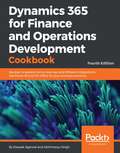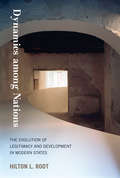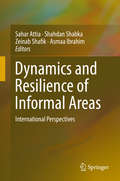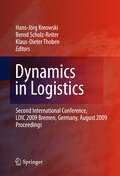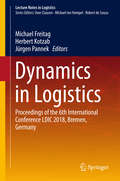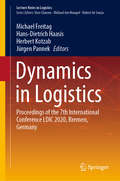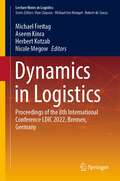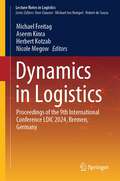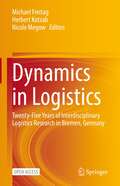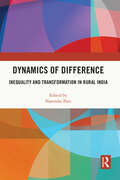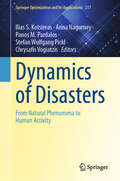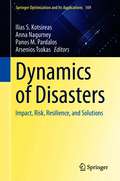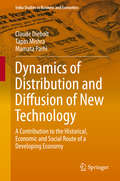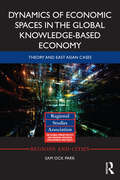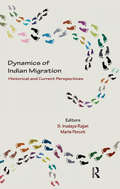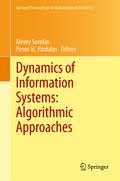- Table View
- List View
Dynamics 365 for Finance and Operations Development Cookbook - Fourth Edition
by Deepak Agarwal Abhimanyu SinghOver 80 effective recipes to help you solve real-world Microsoft Dynamics 365 for Finance and Operations development problems About This Book • Learn all about the enhanced functionalities of Dynamics 365 for Finance and Operations and master development best practices • Develop powerful projects using new tools and features • Work through easy-to-understand recipes with step-by-step instructions and useful screenshots Who This Book Is For If you are a Dynamics AX developer primarily focused on delivering time-proven applications, then this book is for you. This book is also ideal for people who want to raise their programming skills above the beginner level, and at the same time learn the functional aspects of Dynamics 365 for Finance and Operations. Some X++ coding experience is expected. What You Will Learn • Explore data manipulation concepts in Dynamics 365 for Operations • Build scripts to assist data migration processes • Organize data in Dynamics 365 for Operations forms • Make custom lookups using AOT forms and dynamically generate them from X++ code • Create a custom electronic payment format and process a vendor payment using it • Integrate your application with Microsoft Office Suite and other external systems using various approaches • Export and import business data for further distribution or analysis • Improve your development efficiency and performance In Detail Microsoft Dynamics 365 for Finance and Operations has a lot to offer developers. It allows them to customize and tailor their implementations to meet their organization's needs. This Development Cookbook will help you manage your company or customer ERP information and operations efficiently. We start off by exploring the concept of data manipulation in Dynamics 365 for Operations. This will also help you build scripts to assist data migration, and show you how to organize data in forms. You will learn how to create custom lookups using Application Object Tree forms and generate them dynamically. We will also show you how you can enhance your application by using advanced form controls, and integrate your system with other external systems. We will help you script and enhance your user interface using UI elements. This book will help you look at application development from a business process perspective, and develop enhanced ERP solutions by learning and implementing the best practices and techniques. Style and approach The book follows a practical recipe-based approach, focusing on real-world scenarios and giving you all the information you need to build a strong Dynamics 365 for Finance and Operations implementation.
Dynamics among Nations
by Hilton L. RootLiberal internationalism has been the West's foreign policy agenda since the ColdWar, and the West has long occupied the top rung of a hierarchical system. In this book, Hilton Rootargues that international relations, like other complex ecosystems, exists in a constantly shiftinglandscape, in which hierarchical structures are giving way to systems of networked interdependence,changing every facet of global interaction. Accordingly, policymakers will need a new way tounderstand the process of change. Root suggests that the science of complex systems offers ananalytical framework to explain the unforeseen development failures, governance trends, and allianceshifts in today's global political economy. Root examines both the networkedsystems that make up modern states and the larger, interdependent landscapes they share. Usingsystems analysis -- in which institutional change and economic development are understood asself-organizing complexities -- he offers an alternative view of institutional resilience andpersistence. From this perspective, Root considers the divergence of East and West; the emergence ofthe European state, its contrast with the rise of China, and the network properties of theirrespective innovation systems; the trajectory of democracy in developing regions; and the systemicimpact of China on the liberal world order. Complexity science, Root argues, will not explainhistorical change processes with algorithmic precision, but it may offer explanations that match themessy richness of those processes.
Dynamics among Nations: The Evolution of Legitimacy and Development in Modern States (The\mit Press Ser.)
by Hilton L. RootAn innovative view of the changing geopolitical landscape that draws on the science of complex adaptive systems to understand changes in global interaction.Liberal internationalism has been the West's foreign policy agenda since the Cold War, and the West has long occupied the top rung of a hierarchical system. In this book, Hilton Root argues that international relations, like other complex ecosystems, exists in a constantly shifting landscape, in which hierarchical structures are giving way to systems of networked interdependence, changing every facet of global interaction. Accordingly, policymakers will need a new way to understand the process of change. Root suggests that the science of complex systems offers an analytical framework to explain the unforeseen development failures, governance trends, and alliance shifts in today's global political economy. Root examines both the networked systems that make up modern states and the larger, interdependent landscapes they share. Using systems analysis—in which institutional change and economic development are understood as self-organizing complexities—he offers an alternative view of institutional resilience and persistence. From this perspective, Root considers the divergence of East and West; the emergence of the European state, its contrast with the rise of China, and the network properties of their respective innovation systems; the trajectory of democracy in developing regions; and the systemic impact of China on the liberal world order. Complexity science, Root argues, will not explain historical change processes with algorithmic precision, but it may offer explanations that match the messy richness of those processes.
Dynamics and Resilience of Informal Areas
by Sahar Attia Shahdan Shabka Zeinab Shafik Asmaa IbrahimThis volume provides visionary approaches within the multi-disciplines engaged with informal settlements covering three main themes; 'Innovative Policies and Strategies to Informal Urbanism'; 'Production, Operation and the Life-World of Urban Space' and finally 'The Dynamics of Informal Settlements'. The book reflects multi-disciplinary experiences dealing with informality, where authors from a number of global regions present cases, practices and ideologies related to their respective context. This is elaborated through fifteen selected papers, most of which, were presented at the International conference: ARCHCAIRO 6 (the 6th International Conference), "RESPONSIVE URBANISM IN INFORMAL AREAS TOWARDS A REGIONAL AGENDA FOR HABITAT III". The conference was organized as a collaborative activity within the "Informal Urbanism Hub" of the HABITAT University Network Initiative (UNI), the Regional Office for Arab Countries, and Cairo University, aiming at reducing the gap between academia and practice.
Dynamics in Chinese Digital Commons: Law, Technology, and Governance
by Hu LingThe book provides an up-to-date, comprehensive, and critical explanation of digital commons in China.It aims to reshape the theoretical discussion of digital commons, stressing the significance of digital mode of production and power division structure between government and digital platforms—both characters shed light on how China has developed its digital economy and maintained a relatively innovative cyberspace during the past 20 years. This book could serve as a foundational analysis for future studies on China’s Internet.The book will appeal to scholars, entrepreneurs, and policymakers interested in digital commons, governance of cyberspace, and China's political economy.
Dynamics in Logistics
by Bernd Scholz-Reiter Hans-Jörg Kreowski Klaus-Dieter ThobenThe volume comprises the proceedings of the third International Conference on Dynamics in Logistics LDIC 2012. The scope of the conference targeted the identification, analysis, and description of the dynamics of logistic processes and networks. The spectrum ranged from the modeling and planning of processes and innovative methods like autonomous control and knowledge management to the new technologies provided by radio frequency identification, mobile communication, and networking. The growing dynamics in the area of logistics poses completely new challenges: Logistic processes and networks must rapidly and flexibly adapt to continuously changing conditions. LDIC 2012 provided a venue for researchers from academia and industry interested in the technical advances in dynamics in logistics. The conference addressed research in logistics from a wide range of fields, e.g. engineering, computer science and operations research. The volume consists of two invited papers and of 49 contributed papers divided into various subjects including transport logistics, routing in dynamic logistic networks, modeling, simulation, optimization and collaboration in logistics, identification technologies, mathematical modeling in transport and production logistics, information, communication, risk and failure in logistic systems, autonomous control in logistic processes, global supply chains and industrial applications, and the Internet of Things in the context of logistics.
Dynamics in Logistics
by Jürgen Pannek Herbert Kotzab Michael FreitagThese proceedings contain research presented at the 6th International Conference on Dynamics in Logistics, held in February 2018.The integration of dynamics within the modeling, planning and control of logistic processes and networks has shown to contribute massively to the improvement of the latter. Moreover, diversification of markets and demand has increased both the complexity and the dynamic changes of problems within the area of logistics. To cope with these challenges, it must become possible to identify, describe and analyze such process changes. Moreover, logistic processes and networks must be revised to be rapidly and flexibly adaptable to continuously changing conditions. This book presents new ideas to solve such problems, offering technological, algorithmic and conceptual improvements. It primarily addresses researchers and practitioners in the field of industrial engineering and logistics.
Dynamics in Logistics: First International Conference, Ldic 2007, Bremen, Germany, August 2007. Proceedings (Lecture Notes In Logistics Series)
by Jürgen Pannek Herbert Kotzab Michael Freitag Hans-Dietrich HaasisSince 2007, the biennial International Conferences on Dynamics in Logistics (LDIC) offers researchers and practitioners from logistics, operations research, production, industrial and electrical engineering as well as from computer science an opportunity to meet and to discuss the latest developments in this particular research domain. From February 12th to 14th 2020 for the seventh time, LDIC 2020 is held in Bremen, Germany. Similar to its six predecessors, the Bremen Research Cluster for Dynamics in Logistics (LogDynamics) organizes this conference. The spectrum of topics reaches from the dynamic modeling, planning and control of processes over supply chain management and maritime logistics to innovative technologies and robotic applications for cyber-physical production and logistics systems. LDIC 2020 provides a forum for the discussion of advances in that matter. The conference program consists of three invited keynote speeches and 51 papers selected by a severe double-blind reviewing process. Within these proceedings all the papers are published. By this, the proceedings give an interdisciplinary outline on the state of the art of dynamics in logistics as well as identify challenges and solutions for logistics today and tomorrow.
Dynamics in Logistics: Proceedings of the 7th International Conference LDIC 2020, Bremen, Germany (Lecture Notes in Logistics)
by Jürgen Pannek Herbert Kotzab Michael Freitag Hans-Dietrich HaasisSince 2007, the biennial International Conferences on Dynamics in Logistics (LDIC) offers researchers and practitioners from logistics, operations research, production, industrial and electrical engineering as well as from computer science an opportunity to meet and to discuss the latest developments in this particular research domain. From February 12th to 14th 2020 for the seventh time, LDIC 2020 is held in Bremen, Germany. Similar to its six predecessors, the Bremen Research Cluster for Dynamics in Logistics (LogDynamics) organizes this conference. The spectrum of topics reaches from the dynamic modeling, planning and control of processes over supply chain management and maritime logistics to innovative technologies and robotic applications for cyber-physical production and logistics systems. LDIC 2020 provides a forum for the discussion of advances in that matter. The conference program consists of three invited keynote speeches and 51 papers selected by a severe double-blind reviewing process. Within these proceedings all the papers are published. By this, the proceedings give an interdisciplinary outline on the state of the art of dynamics in logistics as well as identify challenges and solutions for logistics today and tomorrow.
Dynamics in Logistics: Proceedings of the 8th International Conference LDIC 2022, Bremen, Germany (Lecture Notes in Logistics)
by Herbert Kotzab Michael Freitag Nicole Megow Aseem KinraSince 2007, the biennial International Conferences on Dynamics in Logistics (LDIC) offers researchersand practitioners from logistics, operations research, production, industrial and electrical engineering aswell as from computer science an opportunity to meet and to discuss the latest developments in thisparticular research domain. From February 23th to 25th 2022 for the eighth time, LDIC 2022 was held inBremen, Germany. Similar to its seven predecessors, the Bremen Research Cluster for Dynamics inLogistics (LogDynamics) organized this conference. The spectrum of topics reaches from the dynamicmodeling, planning and control of processes over supply chain management and maritime logistics toinnovative technologies and robotic applications for cyber-physical production and logistics systems.LDIC 2022 provided a forum for the discussion of advances in that matter. The conference programconsisted of keynote speeches and research papers selected by a severe double-blind reviewing process.Within these proceedings all the papers are published. By this, the proceedings give an interdisciplinaryoutline on the state of the art of dynamics in logistics as well as identify challenges and solutions forlogistics today and tomorrow.
Dynamics in Logistics: Proceedings of the 9th International Conference LDIC 2024, Bremen, Germany (Lecture Notes in Logistics)
by Herbert Kotzab Michael Freitag Nicole Megow Aseem KinraThis book reports on interdisciplinary research and developments in logistics. It describes cutting-edge methods from business economics, operations research, computer science, and electrical and production engineering, applied to solve current problems in logistics. It includes empirical, theoretical, methodological, and practice-oriented contributions addressing the modeling, planning, optimization, and control of processes in supply chains, logistic networks, production systems, and material flow systems and facilities. Gathering peer-reviewed papers presented at the 9th International Conference on Dynamics in Logistics (LDIC 2024), held on February 14-16, 2024, in Bremen, Germany, and continuing the tradition of previous volumes, this book offers extensive information to both researchers and professionals in logistics. Moreover, it emphasizes current challenges such as those related to sustainable business development and digitalization, proposing novel, effective solutions to cope with current issues in different types of industry.
Dynamics in Logistics: Twenty-Five Years of Interdisciplinary Logistics Research in Bremen, Germany
by Herbert Kotzab Michael Freitag Nicole MegowThis open access book highlights the interdisciplinary aspects of logistics research. Featuring empirical, methodological, and practice-oriented articles, it addresses the modelling, planning, optimization and control of processes. Chiefly focusing on supply chains, logistics networks, production systems, and systems and facilities for material flows, the respective contributions combine research on classical supply chain management, digitalized business processes, production engineering, electrical engineering, computer science and mathematical optimization. To celebrate 25 years of interdisciplinary and collaborative research conducted at the Bremen Research Cluster for Dynamics in Logistics (LogDynamics), in this book hand-picked experts currently or formerly affiliated with the Cluster provide retrospectives, present cutting-edge research, and outline future research directions.
Dynamics of Big Internet Industry Groups and Future Trends
by Miguel Gómez-Uranga Jon Mikel Zabala-Iturriagagoitia Jon BarrutiaThis book applies a new analytical framework to the study of the evolution of large Internet companies such as Apple, Google, Microsoft, Facebook, Amazon and Samsung. It sheds light on the dynamics of business groups, which are approached as 'business ecosystems,' and introduces the concept of Epigenetic Economic Dynamics (EED), which is defined as the study of the epigenetic dynamics generated as a result of the adaptation of organizations to major changes in their respective environments. The book augments the existing literature on evolutionary economic thinking with findings from epigenetics, which are proving increasingly useful in analyzing the workings of large organizations. It also details the theoretical and conceptual nature of recent work based on evolutionary economics, mainly from the perspective of generalized Darwinism, resilience and related variety, and complements the work conducted on evolutionary economics by applying the analytical framework of EED. It makes it easier to forecast future dynamics on the Internet by proving that a sizable number of big business groups are veering from their initial paths to take unprecedented new directions as a result of competition pressure, and as such is a valuable resource for postgraduates and researchers as well as those involved in economics and innovation studies.
Dynamics of Controlling Strategy
by Robert L. SimonsControl of business strategy is achieved by integrating the four levers of control. This chapter presents an integrated framework, illustrating that the power of the control levers lies in how they complement each other when used together.
Dynamics of Difference: Inequality and Transformation in Rural India
by Narendar PaniThis original conceptualization provides insights into the role of inequality in the processes of change in rural India. It presents in-depth analyses and understanding of the nature and form of inequality, and its causes and consequences. The volume examines interpersonal, intergroup, and intrapersonal inequalities in the country’s rural transformation. Through research based on ethnographic, primary survey and secondary data methods, this multidimensional study discusses key themes such as normative and descriptive inequalities; class, caste and other identities; economic poverty; educational poverty; poverty in health; gendered poverty; inequality and power; the impact of migration; ethical issues and vulnerabilities; and suicidal consequences of inequality. It builds cohesive arguments, based on the development of several new indicators, to examine rural inequality. This book will be of interest to scholars and researchers of political economy, economics, development studies, development economics, sociology, public policy, political science, political sociology, and rural sociology.
Dynamics of Disasters: From Natural Phenomena to Human Activity (Springer Optimization and Its Applications #217)
by Panos M. Pardalos Ilias S. Kotsireas Anna Nagurney Chrysafis Vogiatzis Stefan Wolfgang PicklBased on the “Sixth International Conference on Dynamics of Disasters” (Piraeus, Greece, July 2023), this volume includes contributions from experts who share their latest discoveries on disasters either caused by natural phenomena or human activities. Authors provide overviews of the tactical points involved in disaster relief, outlines of hurdles from mitigation and preparedness to response and recovery and uses for mathematical models to describe disasters and their impacts. This volume includes additional invited manuscripts from other experts and leaders in the field. Topics covered include economics, optimization, machine learning, government, management, business, humanities, engineering, medicine, mathematics, computer science, behavioral studies, emergency services, and environmental studies and will engage readers from a wide variety of fields and backgrounds.
Dynamics of Disasters: Impact, Risk, Resilience, and Solutions (Springer Optimization and Its Applications #169)
by Panos M. Pardalos Ilias S. Kotsireas Anna Nagurney Arsenios TsokasBased on the “Fourth International Conference on Dynamics of Disasters” (Kalamata, Greece, July 2019), this volume includes contributions from experts who share their latest discoveries on natural and unnatural disasters. Authors provide overviews of the tactical points involved in disaster relief, outlines of hurdles from mitigation and preparedness to response and recovery, and uses for mathematical models to describe natural and man-made disasters. Topics covered include economics, optimization, machine learning, government, management, business, humanities, engineering, medicine, mathematics, computer science, behavioral studies, emergency services, and environmental studies will engage readers from a wide variety of fields and backgrounds.
Dynamics of Distribution and Diffusion of New Technology
by Claude Diebolt Tapas Mishra Mamata ParhiThis book presents a comprehensive study of adoption and diffusion of technology in developing countries in a historical perspective. Combining the development of growth trajectories of the Indian economy in general and its manufacturing industry in particular, the book highlights the effective marriage between qualitative and quantitative methods for a better understanding and explaining of many hidden dynamic behaviors of adoption and diffusion trend in manufacturing industry. The use of various econometric methods is aimed to equip readers to make a judgement of the current state of diffusion pattern of new technologies in India and simulate a desirable future pattern in view of the various pro-industrial growth policies.
Dynamics of Drug Addiction and Abuse in India
by Jatinder Singh Ranjit Singh Ghuman Gurinder KaurThis book analyzes drug addiction and abuse from the perspectives of the state and community in India, with a special focus on North-West regions of India. India lies in the transit route of two major global centres of heroin and cocaine processing: the Golden Triangle of Myanmar, Thailand and Laos towards the East; and the Golden Crescent of Afghanistan, Iran and Pakistan to the West making it vulnerable to drug trafficking and curbing this has been a tough challenge for enforcement agencies. The book looks at: the nature and pattern of drug addiction across the age groups, gender and occupational groups, both in rural and urban areas in India; the socio-economic causes of drug-use and addiction and the various socio-economic costs associated with it; the general perception of family members, police and political leaders on drug addiction as well as rehabilitation; and available mechanisms to address the issue at the level of family, society and government and the changes required in policy to curb drug addiction and use This interdisciplinary book will be of importance to students and researchers of economics, cultural and social anthropology, sociology, police administration, political science, and psychology. It will also be of interest to policy makers, government agencies, social scientists, departments of social and preventive medicine, social workers, civil society, drug-addicts and their families.
Dynamics of Economic Spaces in the Global Knowledge-based Economy: Theory and East Asian Cases (Regions and Cities)
by Sam Ock ParkThis book addresses how economic spaces dynamically change within the context of the global knowledge-based economy. Specifically, it centers the discussion on integrated views of understanding and conceptualizing dynamic changes of global economy under the global megatrends of globalization, knowledge-based economy, information society, service world, climate change, and population aging. Focusing on East Asia, especially on Korea, it deals with case studies regarding the processes and patterns of these global dynamics, looking at economic spaces of various spatial scales and types of economic actors. This book develops a theoretical model for understanding and analysing the dynamics of economic spaces that are being reshaped within the larger global economy. It also emphasizes the analysis of empirical studies at the level of firm, region, and state by considering an evolutionary perspective over time. In developing its theoretical framework, this book examines regional resilience, intangible assets, service innovation, path dependence, and other notions related to the evolution of economic spaces, and incorporates these elements into real-world case studies. The integrated theoretical framework examined here contributes a new perspective on spatial disparities in the global economy. An integral model of service innovation; the integration of path dependence and regional resilience; the interaction between firm and region for the accumulation of intangible assets; and the roles of governments and global firms: these are all essential to understanding the dynamics of economic spaces in East Asia. The theoretical model and case studies in this book suggest policy implications for developing countries, especially in the Asian and African regions, with regard to regional development and innovation policies.
Dynamics of Energy, Environment and Economy: A Sustainability Perspective (Lecture Notes in Energy #77)
by Muhammad Asif Hassan Qudrat-UllahThe book addresses the vital and interwoven areas of energy, environment, and the economy within the field of sustainability research. Fundamental technical details, empirical data, and case studies taking into account local and international perspectives are included. Issues such as energy security, depleting fossil fuel reserves, global warming and climate change, as well as novel energy technologies are covered. The dynamic global response will be discussed from the perspective of policy, technology, and economics.Vital details in the form of text boxes, illustrations, graphs, tables and appendices are included. The book will serve as reference book for upper-level undergraduate and graduate students, researchers, academics, policy makers, NGOs and developmental sector professionals within the field.
Dynamics of Indian Migration: Historical and Current Perspectives
by S. Irudaya RajanThis volume is a multidisciplinary approach to the subject of Indian international emigration and comprises contributions by demographers, economists, sociologists, geographers, anthropologists and historians. The book highlights emerging issues such as the political economy of international migration, skilled and unskilled migration, body shopping, return migration, immigration policies in the Gulf and experiences of emigrants from the states of Kerala and Punjab. It focuses on the current dimensions like skilled migrants in the IT sector of Malaysia, the entrepreneurial ventures of Keralites in the UAE, household remittances, inequality and poverty in Kerala, the gender dimension of Indian migration (with focus on nurses and housemaids in the Gulf) and cross-border migratory movements connected to the European Union, with an overview of the migration of Sikhs and Tamils to France. Finally, it carries a discussion of the evolution of India’s public policies towards its diaspora.
Dynamics of Industrial Capitalism: Schumpeter, Chandler, and the New Economy (The\graz Schumpeter Lectures)
by Richard N. LangloisCo-winner of the 2006 Schumpeter Prize of the International Joseph A. Schumpeter Society.This book explains the shift of the organizational landscape away from vertically integrated firms and towards more specialized entities connected by markets and networks. In doing so, it places in a larger theoretical framework the work of Joseph Schumpeter an
Dynamics of Industry Growth
by Jati SenguptaEconomic growth of a country depends on its industries. The focus of modern growth theory is basically macroeconomics, although neoclassical models use competitive markets and the optimization behavior of households and firms in general equilibrium framework. The emphasis here is on industry growth, where the microfoundations of industry are analyzed in terms of economic efficiency. The various linkages which link firm growth with the industry growth are discerned here under various market structures both competitive and monopolistic. The role of information in facilitating market signals and allowing the adoption of new processes has been especially emphasized in this volume. Many issues of market failure and the suboptimality of competitive equilibria are due to incomplete and imperfect information structures and we need a comprehensive theory of information structures underlying the process of industry growth and its dynamics. This book will be of interest to economists studying economic and industry growth and innovation.
Dynamics of Information Systems: Algorithmic Approaches
by Panos M. Pardalos Alexey SorokinDynamics of Information Systems: Algorithmic Approaches presents recent developments and results found by participants of the Fourth International Conference on the Dynamics of Information Systems, which took place at the University of Florida, Gainesville FL, USA on February 20-22, 2012. The purpose of this conference was to bring together scientists and engineers from industry, government, and universities to exchange knowledge and results in a broad range of topics relevant to the theory and practice of the dynamics of information systems. Dynamics of Information plays an increasingly critical role in our society. The influence of information on social, biological, genetic, and military systems must be better understood to achieve large advances in the capability and understanding of these systems. Applications are widespread and include: detection of terrorist networks, design of highly efficient businesses, computer networks, quantum entanglement, genome modeling, multi-robotic systems, and industrial and manufacturing safety. The book contains state-of-the-art work on theory and practice relevant to the dynamics of information systems. It covers algorithmic approaches to numerical computations with infinite and infinitesimal numbers; presents important problems arising in service-oriented systems, such as dynamic composition and analysis of modern service-oriented information systems and estimation of customer service times on a rail network from GPS data; addresses the complexity of the problems arising in stochastic and distributed systems; and discusses modulating communication for improving multi-agent learning convergence. Network issues--in particular minimum-risk maximum-clique problems, vulnerability of sensor networks, influence diffusion, community detection, and link prediction in social network analysis, as well as a comparative analysis of algorithms for transmission network expansion planning--are described in later chapters.
